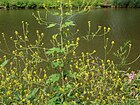Note: This is a project under development. The articles on this wiki are just being initiated and broadly incomplete. You can Help creating new pages.
Difference between revisions of "Brassica nigra"
(→References) |
|||
| Line 67: | Line 67: | ||
==References== | ==References== | ||
<references> | <references> | ||
| − | <ref name="chemical composition">[ | + | <ref name="chemical composition">[Chemistry]</ref> |
| − | <ref name="Leaf">[ | + | <ref name="Leaf">[Morphology]</ref> |
<ref name="How to plant/cultivate">[http://tropical.theferns.info/viewtropical.php?id=Brassica+nigra Cultivation]</ref> | <ref name="How to plant/cultivate">[http://tropical.theferns.info/viewtropical.php?id=Brassica+nigra Cultivation]</ref> | ||
</references> | </references> | ||
Latest revision as of 17:29, 9 November 2020
Brassica nigra is an erect, annual plant. It grows upto 30 - 200cm tall. The plant is often cultivated for its edible seed.
Contents
- 1 Uses
- 2 Parts Used
- 3 Chemical Composition
- 4 Common names
- 5 Properties
- 6 Habit
- 7 Identification
- 8 List of Ayurvedic medicine in which the herb is used
- 9 Where to get the saplings
- 10 Mode of Propagation
- 11 How to plant/cultivate
- 12 Commonly seen growing in areas
- 13 Photo Gallery
- 14 References
- 15 External Links
Uses
Slopecia, Epilepsy, Snakebite, Toothache, Indurations of the liver, Indurations of the spleen, Carcinoma, Throat tumours, Imposthumes.
Parts Used
Chemical Composition
Common names
| Language | Common name |
|---|---|
| Kannada | |
| Hindi | |
| Malayalam | |
| Tamil | |
| Telugu | |
| Marathi | |
| Gujarathi | |
| Punjabi | |
| Kashmiri | |
| Sanskrit | |
| English |
Properties
Reference: Dravya - Substance, Rasa - Taste, Guna - Qualities, Veerya - Potency, Vipaka - Post-digesion effect, Karma - Pharmacological activity, Prabhava - Therepeutics.
Dravya
Rasa
Guna
Veerya
Vipaka
Karma
Prabhava
Habit
Identification
Leaf
| Kind | Shape | Feature |
|---|---|---|
Flower
| Type | Size | Color and composition | Stamen | More information |
|---|---|---|---|---|
| {{{5}}} |
Fruit
| Type | Size | Mass | Appearance | Seeds | More information |
|---|---|---|---|---|---|
Other features
List of Ayurvedic medicine in which the herb is used
Where to get the saplings
Mode of Propagation
How to plant/cultivate
Black mustard is adapted to a wide variety of climatic conditions.[3]
Commonly seen growing in areas
Photo Gallery
References
- ↑ [Chemistry]
- ↑ [Morphology]
- ↑ Cultivation
External Links
Categories:
- Ayurvedic Herbs known to be helpful to treat Slopecia
- Ayurvedic Herbs known to be helpful to treat Epilepsy
- Ayurvedic Herbs known to be helpful to treat Snakebite
- Ayurvedic Herbs known to be helpful to treat Toothache
- Ayurvedic Herbs known to be helpful to treat Indurations of the liver
- Ayurvedic Herbs known to be helpful to treat Indurations of the spleen
- Ayurvedic Herbs known to be helpful to treat Carcinoma
- Ayurvedic Herbs known to be helpful to treat Throat tumours
- Ayurvedic Herbs known to be helpful to treat Imposthumes
- Herbs with Seeds used in medicine
- Herbs with Leaves used in medicine
- Habit - Annual
- Index of Plants which can be propagated by Seeds
- Herbs that are commonly seen in the region of Cliffs near the sea
- Herbs
- Pages without herbs images





